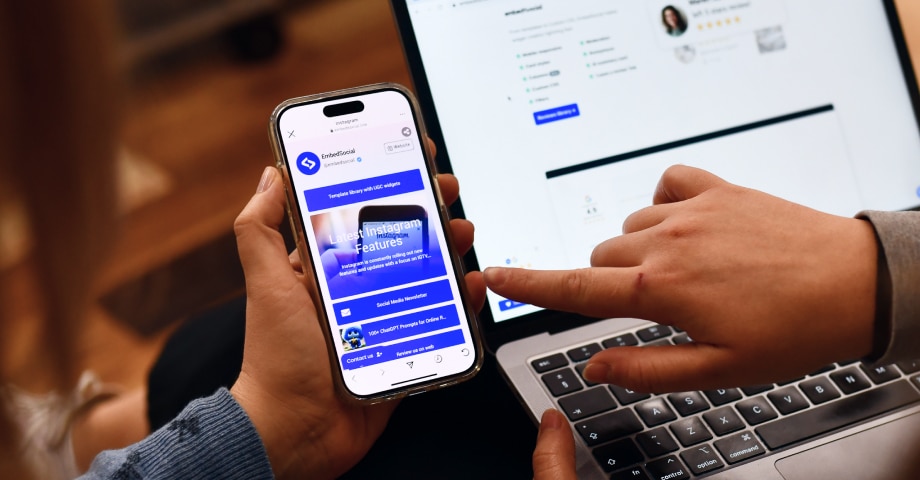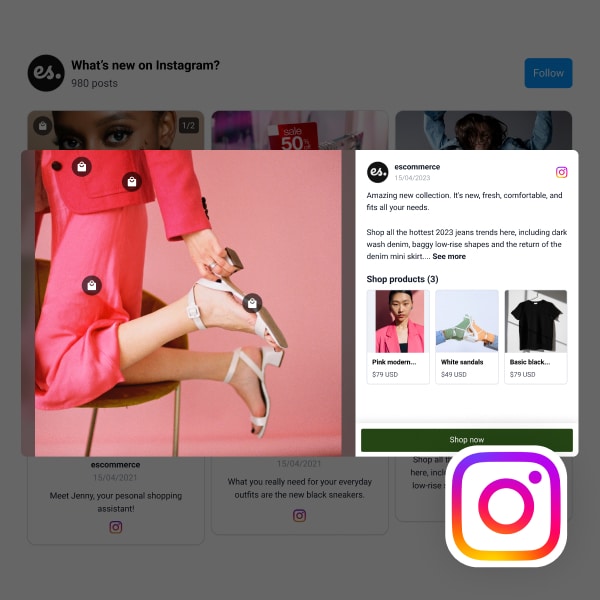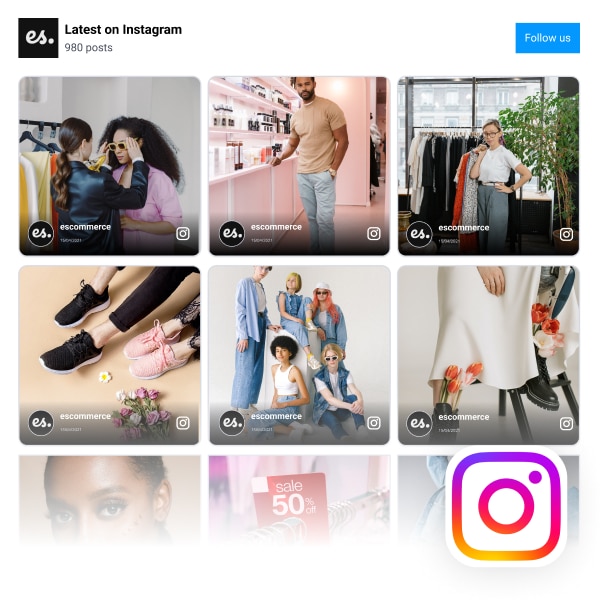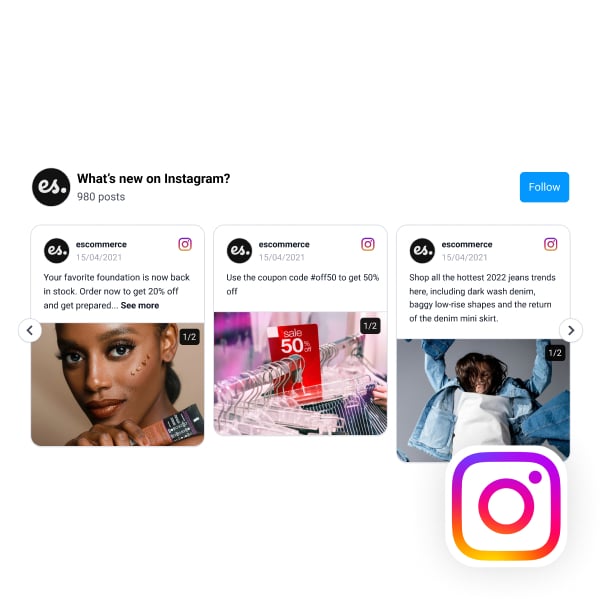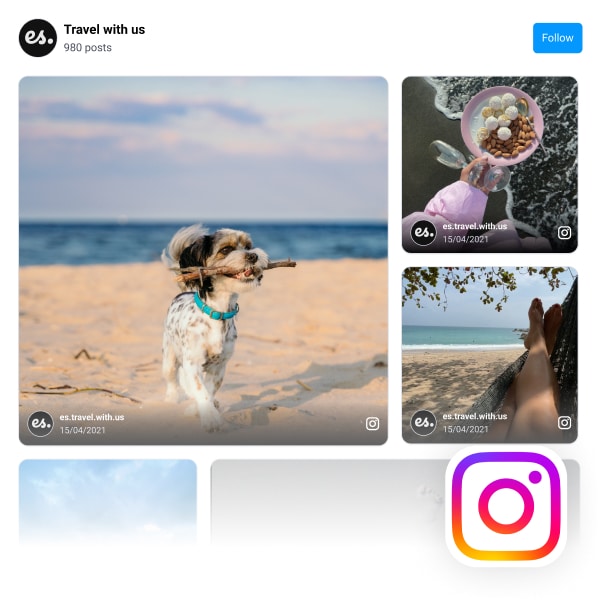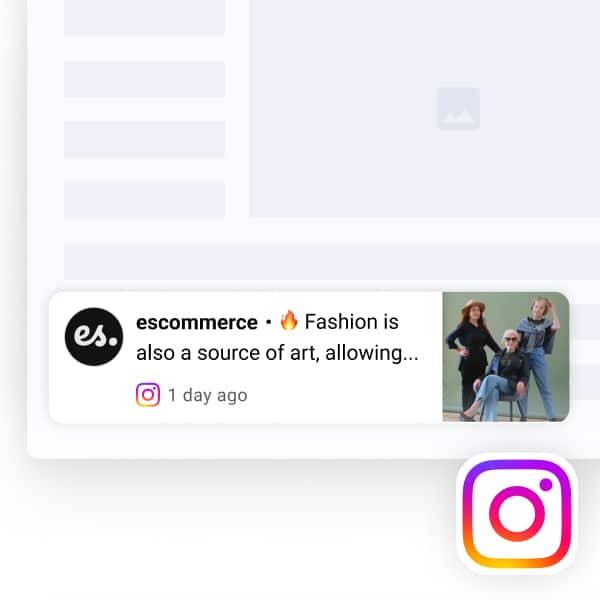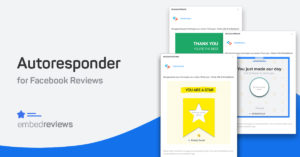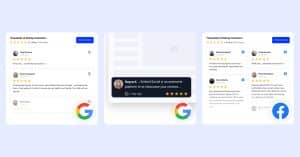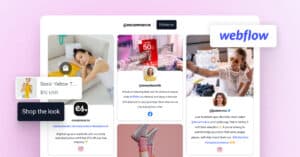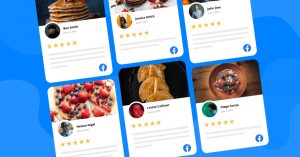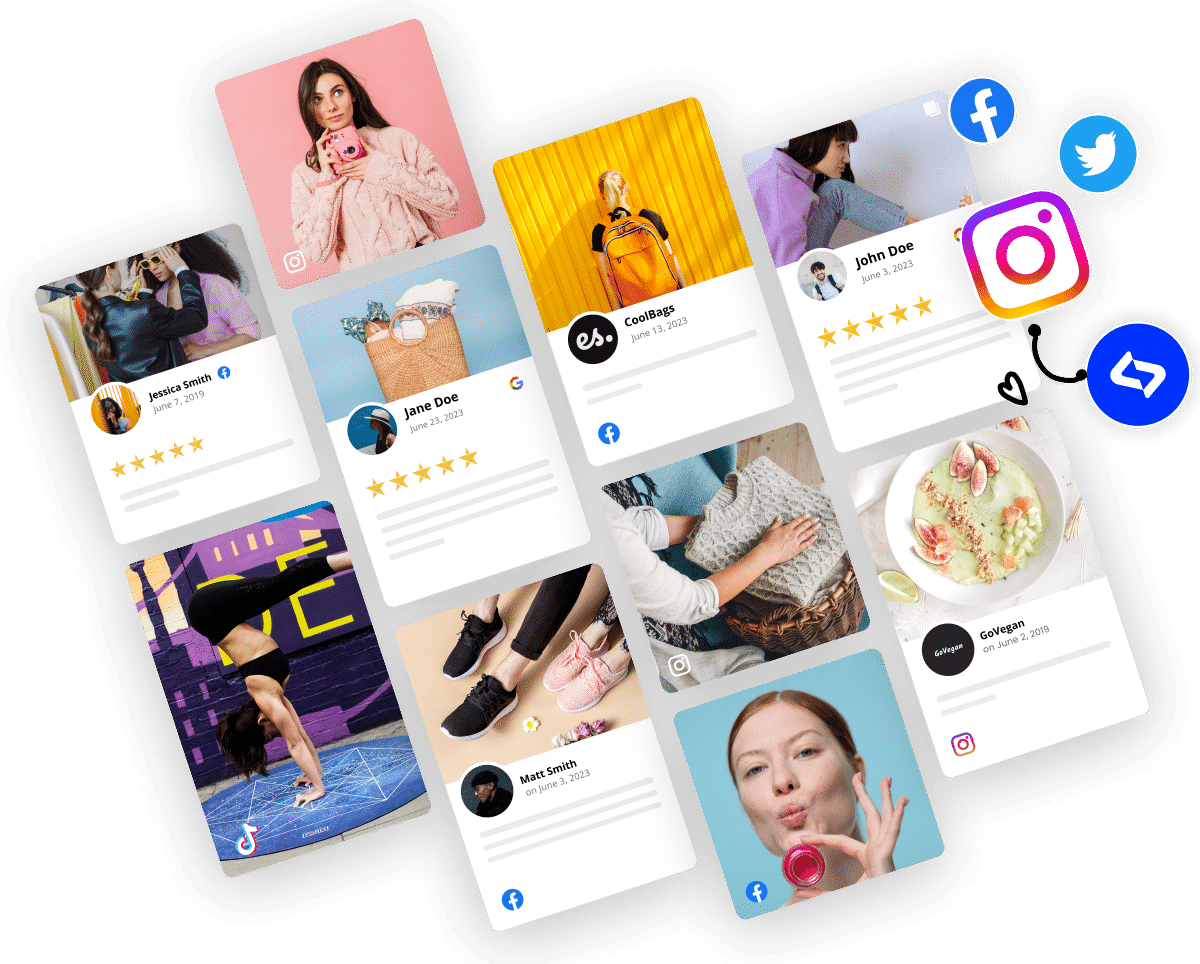As we approach 2024, the role of user-generated content in business strategy is more vital than ever. This article will guide you through ten key UGC best practices and upcoming trends.
We’ll explore how tapping into customer creativity, utilizing influencer marketing, and staying ahead of UGC trends can transform your brand.
With practical tips and real-world examples, you’ll learn how to integrate UGC for a dynamic and engaging brand presence effectively.
What is UGC in the future?
In the future, the definition of User-Generated Content (UGC) is expected to expand beyond its current scope.
UGC in the future will likely encompass not just content created by users, but also content co-created with AI, incorporating advanced technologies like augmented reality, virtual reality, and interactive platforms.
UGC meaning
UGC will become more immersive, personalized, and integrated with real-time data and feedback, making it a more dynamic and interactive element of customer engagement and brand storytelling.
However, unlike employee-generated content, UGC may or may not present specific brand values, but it will and already shows authentic experiences that potential customers can get nowhere else.
FYI: You can embed user-generated content on your website automatically. Sign up now.
User-generated content best practices for the future
Brands and companies looking to get into the UGC game must follow a set of practices that will help them get, manage, and display the best user-generated content out there.
1. Inspire UGC creation with AI like Coca-Cola’s Magic Christmas Cards
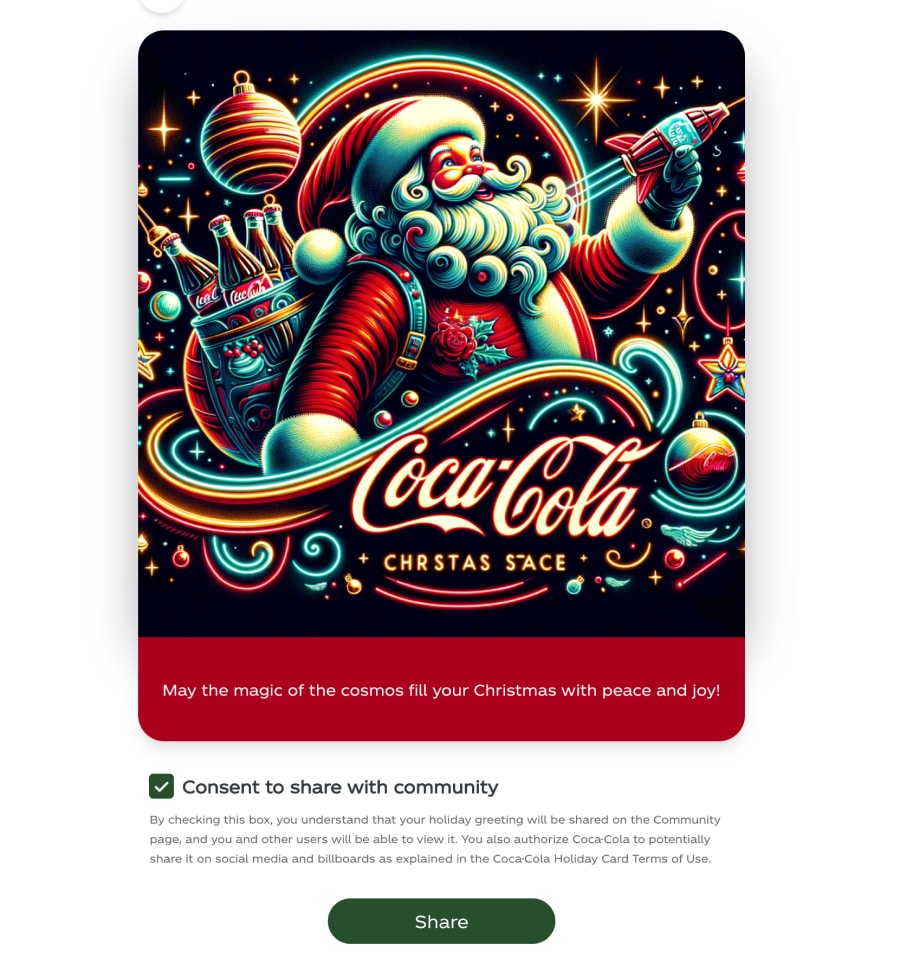
Of course, AI-generated content is not the same as user-generated content, but in this case, people writing the AI prompts are exactly the ones creating the magical cards that Coca-Cola used in their CreateMegic campaign.
Coca-Cola’s holiday campaign, “Real Magic,” invites fans to create digital greeting cards using AI technology. By visiting CreateRealMagic.com, users can reimagine Coca-Cola’s iconic images like Santa Claus and polar bears, creating personalized cards to share online or with friends and family.
This initiative, blending Coca-Cola’s heritage with AI tools like ChatGPT-4 and DALL-E, democratizes creative assets and showcases technological evolution in digital art creation. It builds on the success of a previous campaign, emphasizing the improved image quality and interactive user experience.
Here is my prompt:
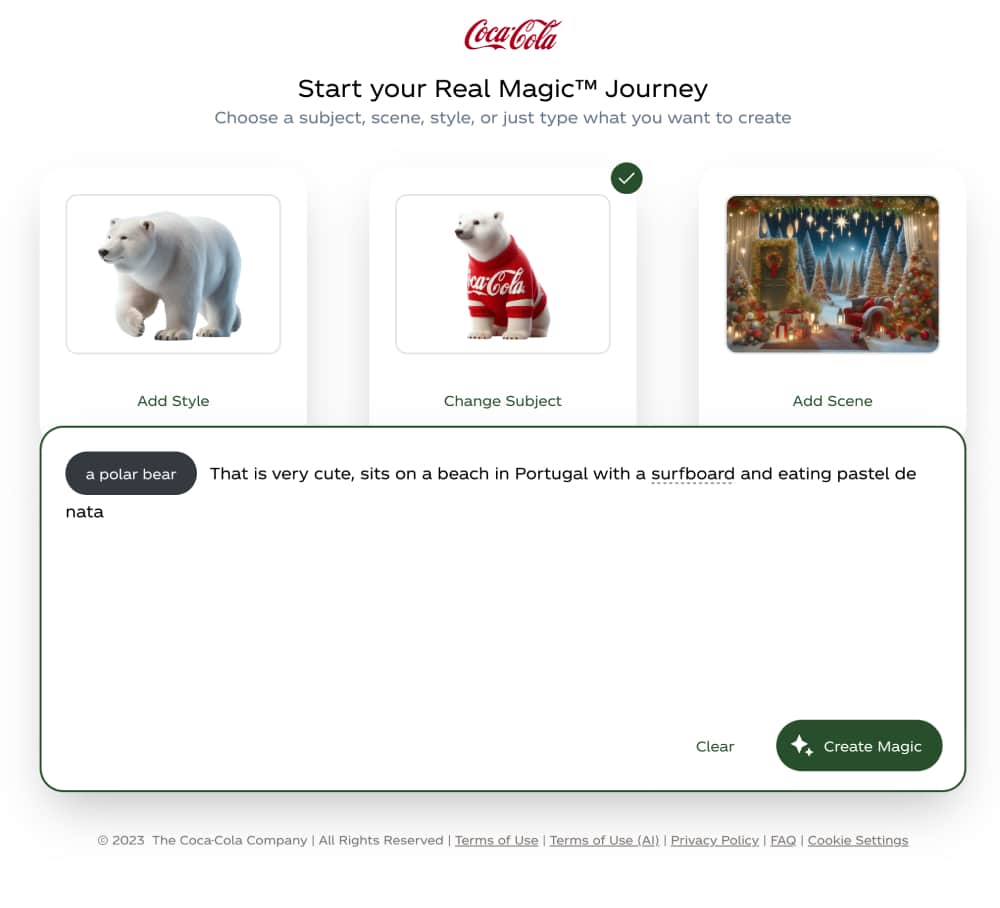
2. Demonstrate your products with UGC like Anna’s everything room by IKEA

IKEA Stories is a great example of using user-generated content to demonstrate the usage of their products. It is powerful because people can connect with the personality of the customer and get inspired by real demonstrations of the IKEA products used in their actual rooms.
For Anna’s Everything Room, potential customers who connect with Ana, a Swedish interior designer, can get a glimpse into her life and decide what to buy for their own rooms.
This strategy helps potential customers visualize the products in their own homes and serves as a testament to the versatility and appeal of the products. Additionally, showcasing UGC creates a sense of community and trust, as its content is created by actual users rather than corporate marketing.
Additionally, IKEA uses a similar approach on their product pages, where they add actual images from users who posted their rooms with the product usage on Instagram. Embedding an Instagram feed on the product page makes it a lot more visually compelling than a stock photo of the product.
3. Encourage authenticity like GoPro’s unique challenges
There’s no substitute for genuine content that shows the exhilarating lives your customers lead, and brands that find a way to tap into that fountain of original content will also get ahead of their competitors. Just look how GoPro does it with their ‘Million Dollar Challenge‘:

What do you need to do? Grab one of GoPro’s cameras, capture life’s epic moments, and hope for your clip to make the cut to get a piece of the pie! Check out this Instagram submission.
You won’t find more authentic content anywhere else!
4. Engage and interact with your community as Glossier does
The best way to foster trust and loyalty and get new customers is to engage and interact with them on all your platforms, starting with social media posts. For this practice, we often mention Glossier mostly because it has one of the best interaction and direct-to-consumer approaches.
They do most of their customer support on social media, which is very impressive. Here is an example:

As you can see from the example, Glossier’s community managers are always eager to respond to user queries to help out in any way they can.
5. Obtain the rights and permissions to publish like Coach
Obtaining copyright permissions from content creators is a crucial step. Otherwise, you might be facing copyright infringement claims. You must also do it to maintain your brand reputation since it’s an ethical practice that respects everyone’s intellectual property.
Check out how Coach—an online fashion brand—does it in Instagram comments
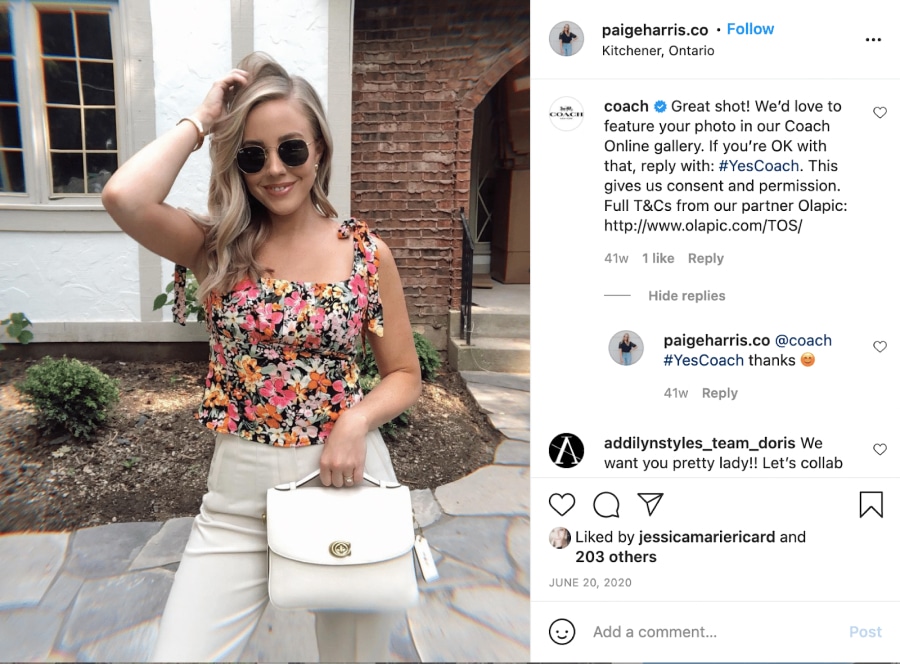
Modern UGC platforms also implement tools that help you automatically request usage permissions from the UGC you collect from the internet.
For instance, EmbedSocial makes it super easy to request UGC rights to republish on Instagram or use the UGC for advertising purposes —you only need to log into your account, go to the ‘All Posts’ section, and install a browser extension. Then, you can send out and track the status of all the requests you want.
6. Reward and recognize top contributors like Calvin Klein
Calvin Klein helps ordinary users get their 15 minutes of fame by showcasing their modeling skills on their official site. The brand is encouraging its customers to share their look wearing Calvin Klein for a chance to be featured on the unique #MYCALVINS web page:

As you can see, every winner is displayed prominently on a gorgeous ‘Wall of Love’ sort of page for the whole world to see. Even if your dreams never come true, this is your second chance for the world of fashion to see you as you are—a gorgeous person wearing Calvin Klein.
7. Show UGC reviews on your website
This is a great use case where brands sync their Google reviews with their website and utilize this type of UGC to engage and build trust on their website.
Also, reviews management software makes it easy to collect reviews and moderate your UGC since it allows you to show the content that matches your message or emphasizes all your pros.
Towards that purpose, Epoxy Genius —a small business specializing in the installation of floors—embeds a Google reviews widget with people’s recommendations and photos of their recent experience with the company.
Also, they use a Google reviews badge to deepen the trust further, showing a 5.0 Google rating on their website:
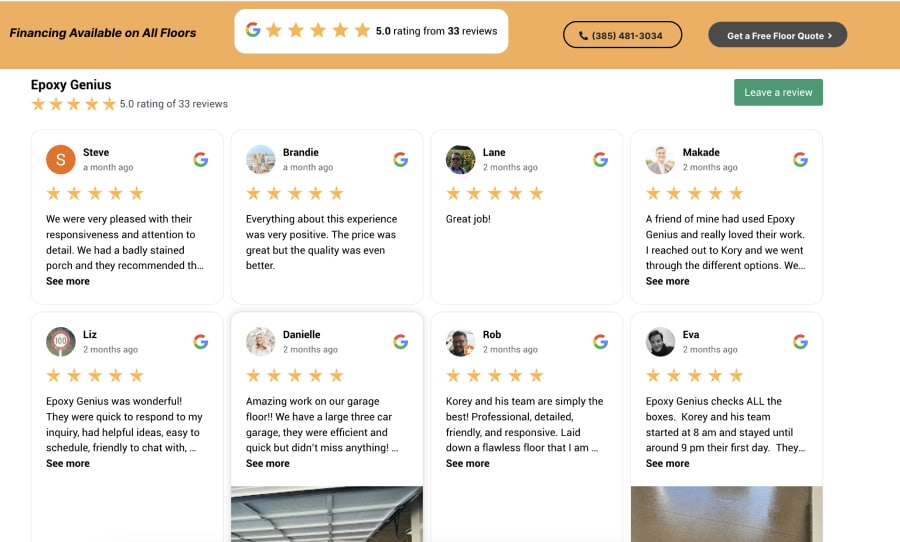
Since the company is using EmbedSocial, they can also toggle their widget to automatically include only those reviews that have a certain number of stars, thus avoiding manual input.
FYI: You can automatically embed Google reviews widget on your website and show authentic user-generated reviews, increasing trust for more sales. Try it now.
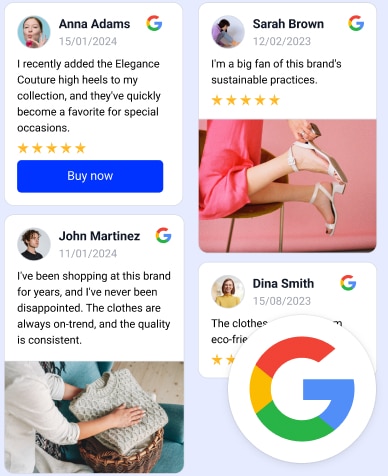
Embed Google Reviews in seconds.
Automatically generate and embed Google reviews and use AI reviews management tools to help you unlock your website’s sales potential.
8. Utilize UGC for multiple platforms like Apple
You must have seen or heard of one of Apple’s latest #shotoniphone campaigns, which was run in 2022 to showcase the capabilities of the iPhone 13 Pro cameras and is still going on with the latest iPhone 15.
This is a great practice of a brand engaging with their audience for the main feature of their latest models.
Photography cameras are a huge market, and there is tons of competition. And with this campaign, people can see how powerful is the iPhone camera and how normal people use it to capture amazing photos and videos.
Here is an example of an amazing video of Coldplay that an Instagram user made only with his phone:
And what did Apple have to do to get this fantastic and multi-purpose UGC? Send out a simple post on Instagram with the hashtag #ShotoniPhone with the promise to exhibit the winning entries all across the internet.
They even used the same concept to sponsor a few music videos, such as the Olivia Rodrigues, which was filmed only on iPhone.
Cool right?
Related:
Find more UGC examples
8. Use a UGC platform to collect and display user-generated content
Last but not least, the best way to ensure the success of your brand’s user-generated content is to utilize a UGC platform built from the ground up to collect, display and manage your UGC.
Here is what EmbedSocial can help you achieve:
- UGC collection: Easily gather user-generated content like social media posts or reviews. You can use SMS and integrations to collect these from various platforms automatically.
- AI Tools for UGC: Simplify review collection and management with AI assistance. Features like AI responses to reviews and AI translation for captions can help you engage more effectively with your audience.
- Interactive UGC widgets: Embed and showcase diverse content from different sources on your website. This could be a mix of reviews, social media videos, and more, making your products more relatable. Here are examples of Instagram widgets for your website:
Want more Instagram feed widgets? Click below to explore more templates.
13 expert tips for leveraging user-generated content for brand growth in 2024
In the fast-evolving landscape of digital marketing, user-generated content (UGC) remains a powerful tool for brand growth. We’ve gathered insights from marketing coordinators to CEOs, distilling their personal experiences into twelve key strategies. From leveraging local micro-influencers to inviting guest posts to your blog, discover how top industry professionals suggest utilizing UGC to expand your brand in 2024.
1. Leverage local micro-influencers
In 2023, I helped local bars leverage micro-influencers in target neighborhoods to grow their traffic and increase sales, proving that it can be a great way to utilize user-generated content to grow in 2024.
Trusted by their communities, local micro-influencers generated genuine UGC related to the bars that resonated better than traditional marketing. This strategy resulted in increased authenticity and trust, and created a hyper-local campaign in a cost-effective way.
Additionally, reaching relevant audiences in target areas was possible due to the micro-influencers focus on specific communities. By looking specifically for local micro-influencers, partnering with the talent was budget-friendly and effective. Furthermore, user-generated content contests can further enhance engagement and generate fresh, authentic content.
Jianwei Kapp, Marketing Coordinator, Achievable
2. Implement diverse UGC campaigns
Brands can use user-generated content to foster trust and authenticity, leading to growth. If you see a photo of someone who has used a product you want to buy, and it has worked for them, you are likely to trust it, right? UGC is like social proof of your product or service. When prospective customers see genuine photos, reviews, or videos, they are more likely to trust the brand.
In 2019, we worked with a travel company that was looking to expand their brand awareness and grow their business. After our analysis, we noticed they did not have any UGC. We implemented a diverse UGC campaign, which included gamification, site widgets, and sending engaging emails encouraging customers to share their reviews and travel experiences with the company.
After three months, there was a surge in quality reviews across their digital platforms. It increased their brand awareness, and they received a surge in bookings. This proves UGC can be the strategy brands need to grow in 2024.
Valerie Lavska, CMO, Promodo
3. Host engaging UGC contests
Our first step was encouraging our customers to share their prepping experiences with us through a contest. The winner would get a $1,200 giveaway and survival gear for sharing their stories or photos. We would repost the content on our channels and credit the original poster, which incentivized our customers.
Following our UGC implementation, we saw a 23% increase in our social media followers in the first six months, which we attribute to the increased visibility from user-generated content. There was also a 35% increase in our customer engagement rate in likes and comments on our posts. Our website traffic also grew by 45%, and there was a 27% increase in sales.
Alex Horsman, Head of Marketing, Ammo.com
4. Promote unique audio testimonials
Using video testimonials for UGC marketing campaigns is a well-known technique. However, few marketers know the potential of audio testimonials for UGC marketing campaigns. It’s a unique marketing approach that can instantly catch the attention of target customers. I’ve tried this method and loved its effects.
As they are hardly visible on digital media, audio testimonials are captivating for the target customers. It created a robust buzz in the market when our brand promoted audio testimonials. Numerous target customers visited our website and social media pages to hear those audio testimonials. It increased the data traffic of our website, and we could even boost our SERP ranking. It became one of our most successful ventures.
Tom Vota, Marketing Director, Gotomyerp
5. Utilize email lists for UGC
A company we work closely with has been successful with UGC by leveraging its email list.
So, if you want more personal context to an Instagram Reel, blog post, or want to create something entirely from scratch using UGC, they send out an email with a Google Form attached (either in the form of a poll or a place where people can leave longer answers) based on what they are looking for.
They then take bits and pieces of the answers and use them across their social media and website in ways that help strengthen everything they’re doing from a content perspective.
John Sammon, CEO and Founder, Sixth City Marketing
6. Create branded hashtag campaigns
From our experience, one effective strategy is to create a branded hashtag campaign. We initiated a campaign where we encouraged our start-up community to share their success stories using a specific hashtag. This not only provided us with authentic content that resonated with our audience but also fostered a sense of community among our users.
This approach is powerful because it turns customers into brand advocates. When users share their experiences with your product or service, it adds a layer of trust and credibility that cannot be achieved through traditional marketing.
For other brands, incorporating user-generated content (UGC) into their marketing strategy can lead to increased engagement, stronger customer loyalty, and a more relatable brand image. It’s about creating a platform where customers feel valued and heard, turning their experiences into a core part of your brand’s story.
Niclas Schlopsna, Managing Consultant and CEO, spectup
7. Turn UGC into PPC media
Brands should turn their user-generated content into media for their pay-per-click ads. We’ve done this ourselves and have seen our cost to acquire customers drop by over 80%.
Justin Silverman, Founder and CEO, Merchynt
8. Host interactive live sessions
We embrace live-streaming platforms and user-generated live content. Hosting interactive live sessions where customers can participate and share their thoughts in real time can foster a sense of community and authenticity. We consider using live Q&A sessions, product demonstrations, or virtual events to engage our audience and encourage UGC during the broadcast.
Hardy Desai, Founder, Supple Digital
9. Edit UGC for social platforms
In 2024, brands can grow by strategically editing and repurposing user-generated content for platforms like TikTok and YouTube Shorts.
From my experience, we can repurpose a single piece of UGC into many different clips. These can then be split-tested to find the perfect combination of engaging and shareable content for your brand. This approach allows you to get maximum value out of UGC and counter creative fatigue by continuously testing new variants.
Tom McCarron, Co-Founder, Algebra Digital
10. Entice customers to partner programs
We’ve found that the best way to generate a consistent flow of user-generated content is by inviting recently purchased customers to our partner program directly within our post-purchase email sequence.
It’s at this point that they are most engaged with our brand and genuinely excited about our products.
We invite them to join our partner program, which pays an affiliate commission for any sales generated through their content, and follow up with tips and tricks for creating great UGC that converts.
While most customers only have small audiences, the number of partners we sign up helps reach a far wider—and more genuine—audience than many other forms of advertising. Of course, we can also use the UGC for paid marketing, which is another bonus!
Ben Donovan, Founder, Brand Builder University
11. Showcase authentic first-time reactions
One effective tip and trend I recommend and have observed is tapping into the power of authentic reactions. Encourage your customers or clients to share their first-time experiences with your product or service through short-form videos. As the owner of a short-form video editing and marketing agency, I’ve seen some amazing results when we suggested this to our clients.
By showcasing genuine reactions on your accounts, you can create relatable content and build trust with your audience at the same time. People love to see real people genuinely enjoying a product—it adds a human touch to your brand and can do wonders for your brand’s growth. However, make sure to make it easy for them to share their content by creating specific hashtags or challenges.
Daniel Willmott, Founder, Shortformvideo.co
12. Provide clear UGC guidelines
Offer clear guidelines on the kind of user-generated content you want. A recent market survey revealed that only 16% of brands actually offer clear guidance on the kind of content they want to see from their users. However, over half of the consumers surveyed stated that they would actually want brands to tell them what they should be doing in terms of UGC.
This mismatch between the brand and its users is leaving a significant amount of potential UGC on the table due to a lack of clear vision on what they actually want to achieve with it. My advice for companies looking to grow via UGC is to flesh out the strategy and subtly start pointing your users in the right direction.
Greg Listopad, Consulting Partner, November Consulting
13. Invite guest posts to your blog
There are many benefits to asking your audience or community members to contribute guest posts to your blog. Not only is this a powerful strategy for freshening up your blog content with diverse perspectives, but it can also lead to increased traffic from channels like organic search and social media.
Brands that take this approach should develop a clear set of guidelines for what they’re looking for from contributors. As an example, you might showcase experts who can write about your industry from a specific angle.
Alternatively, you might do a community spotlight where you feature personal case studies or anecdotes from people who have used your product or service. The latter approach can be a great way to build trust with your audience and create ongoing influencer partnerships.
Chloe Brittain, Founder, Monday Roadmap
Why should you use user-generated content in 2024?
In 2024, embracing user-generated content is crucial for businesses. It offers a raw, unfiltered glimpse into how consumers interact with products, serving as powerful social proof.
In summary, here are the main benefits of user-generated content:
- Display real customer Experiences: Highlight actual customer use cases of your products.
- Establish credibility: Use real user feedback to build trust with potential customers.
- Increase social media interaction: Encourage and share user content to foster engagement.
- Reduce marketing costs: Utilize customer content to save on content creation expenses.
- Understand your audience: Analyze user content for insights into customer preferences.
- Foster brand loyalty: Use customer stories to create a strong community around your brand.
- Widen campaign reach: Share user content to organically extend your marketing reach.
- Improve online visibility: Incorporate user content in your SEO strategy.
- Versatile marketing: Apply user content across multiple platforms for a varied marketing approach.
- Informal market feedback: Treat user content as a source for market trends and feedback.
UGC best practices: Future trends
While UGC marketing is expected to play a pivotal role in all future user-generated content campaign strategies, the ways in which brands will collect, curate, and utilize UGC will rapidly evolve.
Here are some ideas you can do in the future for your UGC campaigns:
Create Interactive content campaigns
Brands can create interactive campaigns where users submit their own video responses. Example: A beauty brand might launch a makeup challenge, encouraging users to showcase their creativity.
Try virtual and augmented reality
Utilize VR/AR for immersive experiences. Example: A travel company could invite users to share VR experiences of their vacations.
Localize content
Focus on regional user content for local market appeal. Example: A food brand could encourage recipes from different cultures using their products.
AI-Enhanced UGC
Implement AI tools to curate or enhance UGC. For example, a fashion brand might use AI to suggest outfit combinations from user submissions.
Promote sustainability through UGC
Encourage content that promotes sustainability, like an eco-friendly brand, which might feature customer stories about reducing their carbon footprint.
Showcase diverse and inclusive customer stories
Represent a wide range of customer backgrounds. For example, a fitness brand could share diverse fitness journeys.
Engage with real-time content
Use live streams or instant updates for immediacy. For example, a sports brand might host live workout sessions.
Analyze UGC for Insights
Employ data analytics to understand user trends. For example, a tech company could collect reviews and feedback for product improvements.
Collaborate with users and customers for content creation
Partner with users for content creation. Example: A music platform might invite users to contribute to a collaborative playlist.
Incorporate UGC in E-commerce
Integrate UGC in product pages. Example: An online retailer could feature customer photos and reviews on product pages. Here is an example of an Instagram UGC shop:
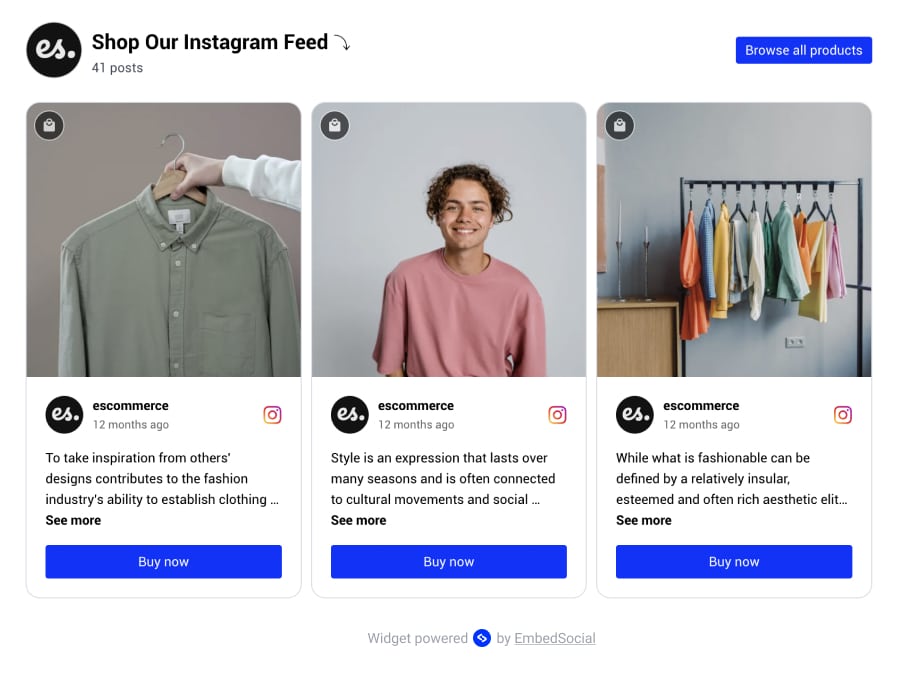
By adopting these best practices, brands can ensure their UGC strategy remains effective and relevant in the ever-changing digital landscape.
After all, user-generated content helps companies stay relevant in the new age of social presence.
Tools like EmbedSocial are implementing these features already, all to provide a platform to aggregate, manage, and showcase UGC efficiently and effectively.
Key takeaways
Brands looking to grow in today’s highly competitive marketplaces must embrace UGC wholeheartedly. Social proof is the buzzword around the marketer’s lobby, and for good reason:
- UGC is crucial for brands as it provides numerous benefits, ranging from authenticity and trust to increased user engagement, brand loyalty, and various SEO benefits.
- When using UGC, you must follow a few user-generated content tips, such as setting the right submission rules, engaging the community, obtaining content rights, rewarding the top contributors, and embedding your UGC across all your social platforms.
- Try EmbedSocial’s UGC platform to get all the tools you need to gather and manage your customers’ UGC fully.
- Moving forward, brands will start relying on AI-powered technologies to collect, moderate, and display user-generated content for more streamlined practices.
All in all, since UGC reflects the voice of real customers, brands must rely on it to significantly amplify their reach and boost their online presence in an effort to reach new users.
Ultimately, even if your user-generated content campaigns fail (they won’t), you won’t lose any real money since you are reusing other resources.
FYI: You can embed user-generated content on your website automatically. Sign up now.
FAQs about using UGC
Suppose you are looking to gather the best UGC for your brand. In that case, you have to keep in mind several tips, including the social networks you’ll be using, setting realistic goals, motivating your customers to generate content, and collaborating with influencers.
UGC strategy is a term used by marketing professionals who collect and create content from real customers in their marketing efforts due to the numerous benefits it comes with. Unlike traditional marketing techniques, UGC is cost-friendly and immediately trustworthy.
There’s no better social proof than UGC as it comes from real people with real experiences. After all, modern consumers want to hear that the service/product they are interested in is the best out there.
To have an impact, UGC ads should look authentic. Therefore, they should feel rough around the edges since everyday users don’t have the resources to produce studio-quality ads.
UGC acts as social proof, influencing potential customers through real experiences and recommendations; thus, UGC impacts purchasing decisions very effectively.
Yes, UGC can boost SEO through fresh, relevant content and increased user engagement.
Always seek permission from creators and understand copyright laws when using UGC.
Track engagement, conversion rates, and mentions to gauge its effectiveness. Platforms like EmbedSocial can help you measure and analyze the impact of UGC on your website.

